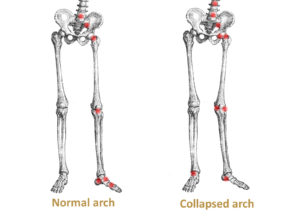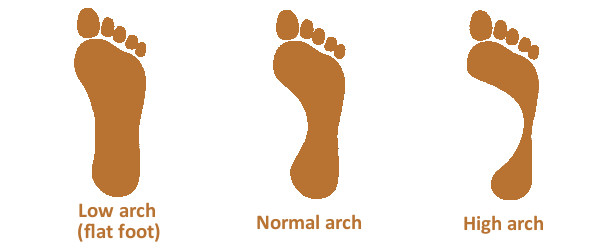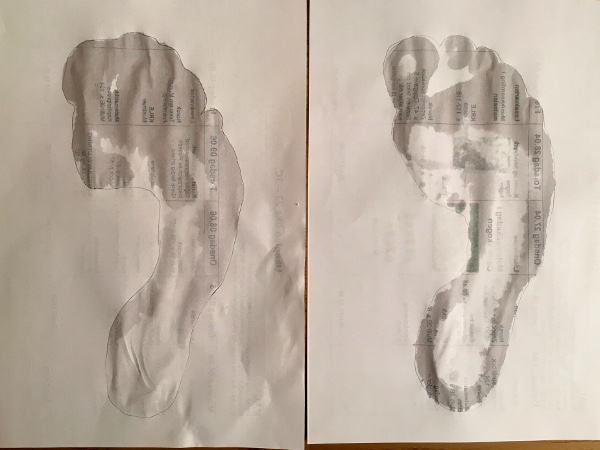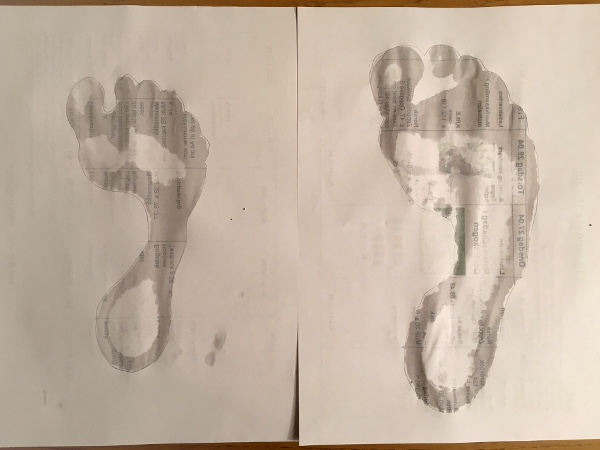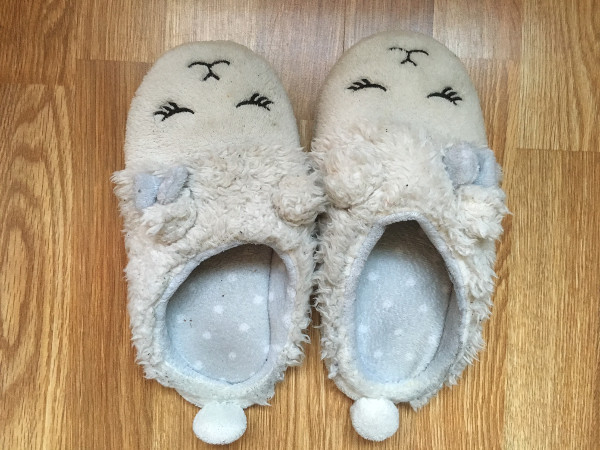Arches of the foot
Foot arch is a bone in our feet formed by metatarsal and tarsal bones. They are naturally shaped in an angle and supports the weight of the body.

Why do your feet have arches?
Humans developed foot arches evolutionary. Apes have flat feet and no support to walk up straight. It takes huge amounts of energy to walk without arches. A normal arch is naturally the best structure you can have in order to be able to stand, walk and run.
As we see from the illustration with normal arched foot, stress from the body weight goes vertically down to the arch and is absorbed by the arches. In case of collapsed arches more stress goes to the bones and joints of the leg, hips and the spine. This will cause more wear and injuries to the skeleton with time.
Types of feet arches
There are three main foot arch types: normal, high and low.
Normal or medium arch is an arch where approximately half of your arch area touches the ground. This is the best and most common type of arch. Around 60% of people have normal arches.
Low arch, collapsed arch or flat foot is a type of arch where most of your arch area is on the ground. If you have this type of arch you may notice that your footwear is usually worn down on the inwards. This is an imbalanced foot arch that tend to give more foot problems with knees or arch pain and plantar fasciitis. Around 20% of people have flat feet. If you have low arches you should take proper care of your feet by choosing the right shoes and wearing orthotics. Children with flat or normal-to-low arches should wear footwear that will strengthen their arches.
High arch is an arch where little to no area is touching the ground while you walk. Such arches are more rigid and don’t absorb stress as well. Most of the pressure goes on to the rear-foot or the ball of the foot. Around 20% of people have high arches. Your footwear tend to wear out on the outside of the heel area. If you have high arches you should choose cushioned shoes with good arch support. The arch support will take some of the stress from your body and prevent the damage of your feet.
To find out what type of the arch has your foot take a wet test or look at your shoes that your wear very often (typically soft home slippers).
Wet test
The wet test is easy to perform but may be inconclusive. Unless your have very high or low arch it may be difficult to understand the result.
Here is how you do it:
- Wet your foot in the shower.
- Take a piece of paper and place your foot on it for 30 seconds.
- See the result.
Take the test one more time if the shape of your foot came out strange. Here is an example of wet test of the same foot. See how different the shape is:
Here is another example of high arch foot along with a normal-to-low arch. It’s difficult to see that the left footprint has a high arch:
Slippers may be a better indicator of a high arch. See how these are worn out on the outer side of the heel:
How high should your foot arch be
So, what is the normal arch? A normal or medium arch fills about half of the arch region. It is more desirable to have a slightly flatter (or pronated) foot that rolls inwards. There have been some military studies that showed that it is slightly more damaging to have a high arch, than a low one.
High arched feet versus low arch feet
High arches feet
As we’ve seen earlier cavus foot or a high arched foot is a type of foot where the bottom of the foot touches the ground mostly at the front and at the heel areas. There are several causes to high arches:
- Natural. Some people inherit high arches. If your father or mother have high arches chances are you will get too.
- As a result of a medical condition. Several movement disorders like cerebral palsy may give high arches. Other examples are a club foot deformity or various neuromuscular diseases like poliomyelitis.
- Nerve trauma.
There are several problems with high arches:
- You may experience difficulty buying shoes. Not all shoes are deep enough for very high arches which may give discomfort.
- Depending on the arch height you may experience pain while walking, running and even when standing.
- You may experience pain in your knees, hips and the back.
- Toe deformations like hammertoes or claw toes.
- Dragging the foot while walking. this is usually the result of a weakness of the muscles.
- Dropping of the foot while walking.
High arched foot is beneficial for ballet dancers as it helps to be en pointe. Naturally, many dancers will make everything to develop a high arch. But is it possible?
Researching ballet dance shows that although you can’t change your bone structure, you may improve your arches with a set of special exercises called Ballerina workout. Here is how to get high arched feet:
If you have high arches already than you may be interested to know what type of shoes to wear. As your foot doesn’t have a good natural stress absorption you would need to wear shoes that have padding and arch support. This will help distribute your body weight along the foot instead of pressuring on the heels and ankles.
amzn_assoc_placement = “adunit0”;
amzn_assoc_search_bar = “false”;
amzn_assoc_tracking_id = “monsterfreyan-20”;
amzn_assoc_search_bar_position = “top”;
amzn_assoc_ad_mode = “search”;
amzn_assoc_ad_type = “smart”;
amzn_assoc_marketplace = “amazon”;
amzn_assoc_region = “US”;
amzn_assoc_title = “High arch shoes and inserts”;
amzn_assoc_default_search_phrase = “high arch shoes”;
amzn_assoc_default_category = “Shoes”;
amzn_assoc_linkid = “b1fd7d421c16aa50f2208ccce954ec79”;
There are some exercises you should do from time to time in order to prevent foot pain in high arched feet. You can’t make your arches lower, but you need to ensure the mobility of your foot. The worst thing you can have is a fixed arch where your arches aren’t moving or stretching.
We recommend that you do these exercises several time a week:
Low arches feet
 Low arches, collapsed arches or flat feet is the type of foot bone structure when your feet are almost flat. This structure is not particularly stress absorbing causing the joints of your skeleton take most of the pressure.
Low arches, collapsed arches or flat feet is the type of foot bone structure when your feet are almost flat. This structure is not particularly stress absorbing causing the joints of your skeleton take most of the pressure.
There are several causes of low arches:
- Inheritance. If your parents have low arches chances are you have them too.
- Different medical conditions like damaged muscles or rheumatoid arthritis.
- Nerve trauma.
- Obesity and pregnancy. Heavy body have a lot of pressure of the bones. If your feet muscles aren’t strong your arches may collapse.
- Damaged bones of the foot as a result of an injury or a disease.
- Diabetes.
A flat foot is often seen in children because their arches are not yet developed. You should choose the right shoes for your child to ensure developing of strong arches.
If your have low arches you may experience several problems throughout life:
- You feet will get tired fast as your arches aren’t supporting your weight. This may become a problem if you choose a workplace where you need to be standing on your feet all day.
- Foot pain.
- Foot movement may become a problem. You may not stand on your toes as easily as people with normal and high arches. You can not be a ballet dancer.
- Feet are rolling inwards causing shoes to wear out faster.
Difference between low arches and flat feet
Low arches and flat feet are not the same. A flat foot is a naturally low arch. All other types of low arches like fallen or collapsed arch are the result of weak muscles, broken bones or diseases.
The difference between low arches and flat feet becomes important when talking about how to fix flat feet. You can’t fix a flat foot. This is a natural condition often inherited from your parents. But you CAN fix a fallen arched foot!
There is a combination of different methods that you will need to follow throughout your life in order to fix collapsed arches also called a low arches flat feet routine:
- Walk barefoot as much as possible. This will strengthen the foot muscles and help develop a strong arch.
- Choose the right shoes. The less there is to a shoe the better.
- Wear inserts that will help build your arches.
amzn_assoc_placement = “adunit0”;
amzn_assoc_search_bar = “false”;
amzn_assoc_tracking_id = “monsterfreyan-20”;
amzn_assoc_search_bar_position = “top”;
amzn_assoc_ad_mode = “search”;
amzn_assoc_ad_type = “smart”;
amzn_assoc_marketplace = “amazon”;
amzn_assoc_region = “US”;
amzn_assoc_title = “Low arch shoes and inserts”;
amzn_assoc_default_search_phrase = “low arches shoes”;
amzn_assoc_default_category = “Shoes”;
amzn_assoc_linkid = “b1fd7d421c16aa50f2208ccce954ec79”; - Exercise. The aim of the exercises is to fix the weakness of the foot muscles and rebuild ankle strength.
